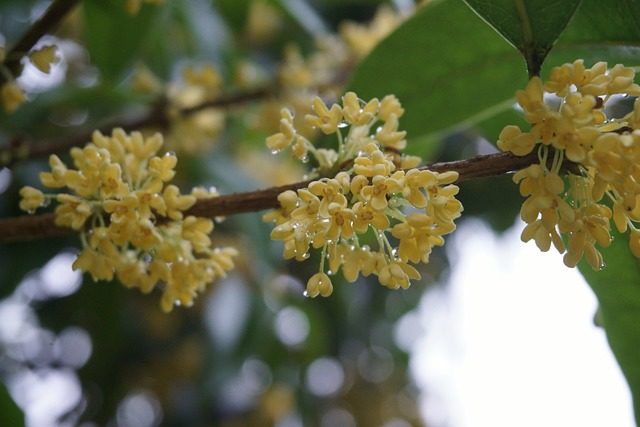Imagine strolling through a garden filled with beautiful flowers, and suddenly, your senses are captivated by an enchanting aroma. This sweet, apricot-like scent is emanating from the delicate blooms of the Osmanthus flower, a captivating flowering shrub with a rich history and cultural significance. In this blog post, we will explore the allure of the Osmanthus flower, its origin, and significance, as well as its many uses, from gardening to brewing a delightful and healthful tea. Join us on this fragrant journey and discover how you can incorporate the captivating charm of Osmanthus into your life.
Table of Contents
Key Takeaways
The Osmanthus flower is renowned for its captivating scent and attractive appearance, used widely in tea, perfumes, culinary applications and aromatherapy.
It is low maintenance to grow with minimal care required in well-drained soil with balanced pH.
Incorporate into your garden design for a visually appealing and aromatic atmosphere. Ideal as natural barrier or screen hedge or container gardening.
The Alluring Osmanthus Flower

With origins in the eastern parts of Asia such as China, Japan, Korea, and the Himalayas, Osmanthus is a genus encompassing around 30 species of fragrant flowering plants. The name “Osmanthus” comes from Greek, translating to “fragrant flower.” The plant’s alluring scent has made it a favorite in various uses, including:
the preparation of the well-loved osmanthus tea
perfumes and fragrances
culinary applications, such as flavoring desserts and beverages
traditional medicine and aromatherapy
The flowers bloom in early spring, releasing a sweet aroma reminiscent of peaches and honey, leaving a lasting impression on those who encounter it.
Origin and Significance
The enchanting Osmanthus flower has deep roots in Asian cultures, particularly in China and Japan, where it symbolizes love and happiness. The captivating scent of these flowers has been cherished for centuries and is still used today in various applications, such as:
osmanthus tea
perfumes
skincare products
aromatherapy
The evergreen shrub produces small, white or yellow blossoms that emit a potent and captivating fragrance, making it a prized addition to any garden.
Fragrance and Appearance
The sweet, apricot-like aroma of the Osmanthus flower is what truly sets it apart from other flowering plants. The scent is often described as a delectable, honeyed, apricot-peachy fragrance with floral and fruity undertones, reminiscent of jasmine with a hint of sensuality.
The small, white or yellow blossoms add to the plant’s charm and allure, making it a popular choice for gardeners seeking both beauty and fragrance in their plants.
Growing and Caring for Osmanthus
One of the many appeals of Osmanthus is that it is a low-maintenance plant that can thrive in a variety of conditions, making it an excellent addition to any garden. Whether you are an experienced gardener or a novice, Osmanthus offers beauty and fragrance without the need for constant care.
This part delves into the optimal conditions for growing Osmanthus along with the most effective methods for pruning and maintaining this beautiful plant.
Ideal Conditions
Osmanthus prefers well-drained soil, with a pH balance ranging from acidic to alkaline. It can thrive in various soil types, including chalk, clay, sand, or loam.
When it comes to sun exposure, Osmanthus is quite adaptable, flourishing in both full sun and partial shade. Moderate watering is recommended, particularly during the initial year of planting, to ensure the plant establishes a strong root system.
Osmanthus’s ability to tolerate drought allows it to survive periods of scarce water, marking it as a hardy choice for diverse garden environments.
Pruning and Maintenance
Regular pruning of Osmanthus helps maintain the desired shape and encourages healthy growth. The best time to prune this plant is at the end of winter, just before the emergence of new growth and buds. Utilize sharp pruning shears and make clean, neat cuts to avoid damaging the plant.
Pruning not only ensures a tidy appearance but also promotes the growth of more fragrant flowers, allowing you to enjoy the captivating aroma of Osmanthus throughout your garden.
Popular Osmanthus Varieties
While there are many species of Osmanthus to choose from, some varieties stand out for their unique characteristics and fragrances. Next, we present three popular Osmanthus varieties: Sweet Olive (Osmanthus fragrans), Tea Olive (Osmanthus heterophyllus), and False Holly (Osmanthus x fortunei).
Each variety offers its own distinct charm and aroma, making them excellent additions to any garden.
Sweet Olive (Osmanthus fragrans)
Sweet Olive (Osmanthus fragrans) is a popular variety of Osmanthus known for its strong, sweet fragrance. This evergreen shrub produces white or yellow flowers and can grow quite tall, reaching up to 10 feet in height and width.
Sweet Olive is drought-tolerant and can withstand a wide range of soil types, making it an adaptable and resilient choice for any garden. The captivating scent of Sweet Olive will surely enhance the beauty and atmosphere of your outdoor space.
Tea Olive (Osmanthus heterophyllus)
Tea Olive (Osmanthus heterophyllus) is another versatile variety of Osmanthus that boasts a twice annual blooming cycle, making it a delightful addition to any garden setting. This slow-growing shrub can reach heights and widths of up to 8 feet and is drought-tolerant, preferring well-drained soil.
Its fragrant white flowers and dark green, glossy leaves make Tea Olive an excellent choice for use as a hedge or specimen plant, offering both beauty and privacy in your garden.
False Holly (Osmanthus x fortunei)
False Holly (Osmanthus x fortunei) is a hybrid variety of Osmanthus that brings a touch of uniqueness to the garden. With holly-like leaves and a more subtle fragrance than other varieties, False Holly offers an elegant and understated charm.
This evergreen shrub is slow-growing and can reach up to 8 feet in height and width. Like other Osmanthus varieties, False Holly is drought-tolerant and prefers well-drained soil, making it a resilient and appealing addition to any garden setting.
Osmanthus Tea: A Fragrant and Healthful Beverage

Osmanthus tea is a delightful and beneficial herbal tea made from the dried flowers of the Osmanthus fragrans tree. Known for its sweet and buttery aroma, osmanthus tea is a caffeine-free alternative to traditional teas, making it a popular choice for those seeking a fragrant and healthful beverage.
Now, let’s delve into the taste characteristics of Osmanthus tea, its possible health advantages, and the process to prepare a flawless cup.
Flavor Profile
The unique flavor of Osmanthus tea is characterized by its sweet, floral taste, with hints of apricot and peach. This delightful flavor profile is reminiscent of rock sugar, rice cakes, and sweet summer apricots, making it a refreshing and enjoyable beverage.
Whether you are an avid tea enthusiast or simply looking to try something new, Osmanthus tea offers a delightful and aromatic experience that is sure to please your palate.
Health Benefits
Rich in antioxidants, Osmanthus tea is believed to offer numerous health benefits, often associated with traditional Chinese medicine. Its antioxidant properties can help strengthen the immune system, detoxify the body, and promote skin health.
Additionally, Osmanthus tea has been known to aid digestion, reduce inflammation, and promote relaxation. With its unique flavor and potential health benefits, Osmanthus tea is not only a delightful beverage but also a nourishing and beneficial addition to your daily routine.
For more info, visit Osmanthus Tea – Ancient, Traditional, and Modern Benefits
Brewing Osmanthus Tea
For a flavorful and aromatic cup of Osmanthus tea, just infuse 1 teaspoon of dried Osmanthus flowers in 8 ounces of boiling water for 3-5 minutes. The steeping time can be adjusted according to your taste preference.
If you prefer a cold beverage, you can also steep the dried flowers in 8 ounces of cold water overnight. Whether enjoyed hot or cold, Osmanthus tea offers a delightful and aromatic experience that is sure to delight your senses.
Incorporating Osmanthus into Your Garden Design
With its captivating fragrance and attractive appearance, Osmanthus makes an excellent addition to any garden design. This section provides different strategies for adding Osmanthus to your garden, such as utilizing it as a natural screen hedge, in container gardening, and in mixed borders and forest gardens.
By integrating Osmanthus into your garden design, you can enhance the beauty and fragrance of your outdoor space, creating a serene and inviting atmosphere.
Natural Barrier or Screen Hedge
One way to incorporate Osmanthus into your garden is by using it as a fragrant and attractive natural barrier or screen hedge. By planting Osmanthus in a row, you can create a thick and visually appealing hedge that offers both privacy and a delightful aroma.
In addition to providing seclusion, Osmanthus hedges can also help obstruct wind, buffer noise, and create more private outdoor living spaces. The captivating scent of Osmanthus makes it an ideal choice for creating a barrier or screen hedge near pathways, patios, or entrances.
Container Gardening
Another way to incorporate Osmanthus into your garden is through container gardening. Growing Osmanthus in containers allows you to enjoy the beauty and fragrance of the plant in a more versatile and portable manner.
When selecting a container for your Osmanthus plant, opt for a sizeable vessel with drainage holes at the base. A well-drained soil mix is recommended, and regular watering is essential to ensure the plant thrives.
By growing Osmanthus in containers, you can easily move the plant to different areas of your garden or patio, allowing you to enjoy its captivating aroma wherever you please.
Mixed Borders and Forest Gardens
Osmanthus can also be integrated into mixed borders or woodland gardens, where it adds visual interest and fragrance to the landscape. When planting Osmanthus in these settings, it is essential to ensure the plant receives adequate sunlight and well-drained soil for optimal growth.
By incorporating Osmanthus into mixed borders or forest gardens, you can create a naturalistic and aromatic perennial border that provides a serene and inviting atmosphere for you and your guests to enjoy.
Summary
Throughout this blog post, we have explored the captivating allure of the Osmanthus flower, its historical and cultural significance, and the various ways it can enhance your garden and daily life. From brewing a delightful and healthful tea to creating a fragrant and visually appealing garden design, Osmanthus offers beauty, fragrance, and versatility that can be enjoyed by all. We hope this exploration of Osmanthus has inspired you to incorporate this enchanting plant into your life, allowing you to experience its captivating charm and aroma firsthand.
Frequently Asked Questions
What is osmanthus flower good for?
Osmanthus is a well known herb in Traditional Chinese Medicine that is beneficial for skin, detoxification, throat relief and lung health. It can be consumed as tea to treat symptoms of dry skin or hoarseness.
What does osmanthus flower smell like?
Osmanthus is a sweet, fragrant flower native to Asia with a unique odour profile of fleshy and floral notes, as well as jammy peach and apricot nuances and a deep, dark undercurrent of leather.
What is the myth of osmanthus?
Osmanthus fragrance is a symbol of prosperity and auspiciousness in Chinese culture, as it is associated with Houyi and his wife Chang’e in mythology. Legend has it that a sweet osmanthus grows on the moon that was endlessly cut by Wu Gang, signifying faithfulness, fertility, peace, and prosperity. Additionally, Osmanthus fragrans flowers are also known as gui hua, which symbolizes true love.
What is osmanthus flower in Chinese medicine?
In Chinese medicine, Osmanthus flower is used as a strong cleansing agent to help treat issues related to the kidneys, liver, and endocrine system. It helps your body get rid of toxins present in the kidneys and liver, making you feel refreshed and energized. According to a study published in the Journal of Functional Foods, Osmanthus also has a good amount of phenolic acid.
What is the ideal sun exposure for Osmanthus?
Osmanthus prefers partial to full sun exposure, making it an ideal choice for sun-filled gardens.









